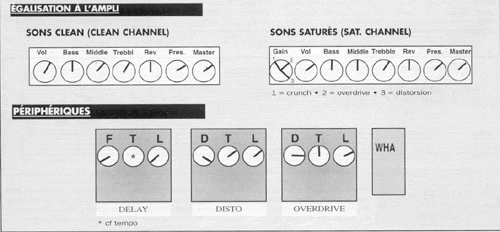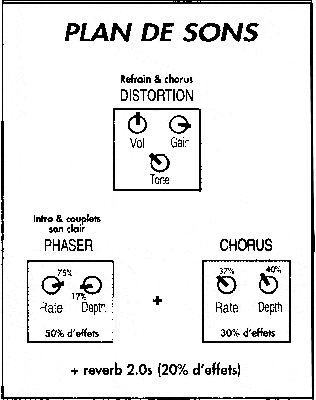Some techniques
Appeared at Hawaï the
last century the slide technique consists of playing not by fretting
the strings but by moving on these ones an object in metal allowing
to relize these so caracteristics
slides before or after the notes.
We have found this technique
in blues with the use of the bottleneck.
It is possible to play
in slide on his habitual guitar but some changes are necessary in
order to avoid some "unpleasant" noises...
Firstky you have to increase
the draught of your strings (light at the minimum), then you have
to increase the action of the strings by going up the pontets of the
bridge (for an electric guitar) or by using a booster, which is put
betwwen the strings and the sillet (for acoustic).
Finally you have to choose
a bottleneck or a slide bar (if you want to imitate Ben perfectly...)
The bottlenecks are :
 |
in
steel, resonant but interferences.
|
 |
in
copper, less sustain but a warmer sound.
|
 |
in
glas, for a duller sound and fast parts (like in the solo of Burn
to Shine). |
There are too differences
about the thickness and the lengh. Let me tell you for example that
we use the shorts for a mixt play frets/slide.
For the positionon of
the bottleneck you have the choice (personal advice : take the finger
with the one you feel at ease); either the little finger for a mixt
play or the third finger.
The play in slide requires
generally a tuning different than the standart tuning, the tunings,
which are the most used by Ben are the followings :

At the right of each
tuning, you can upload the sound in mp3.
ampli equalisations :


Microphones, an interview
of Ben Harper about Seymour Duncan microphones he uses :
Groundwire: How were
you introduced to Duncan pickups?
Ben Harper :
I never stop trying to better my tone.
When you’re in constant pursuit of a tone that is perfect for
you, you end up going through a lot of different guitar makers and
pickup manufacturers. The way I came across Duncan was through a friend,
Keith Nelson from Buckcherry. He met a guitar builder from New Jersey
named Rob Mondell of Justin Sain Guitars who had made him some guitars.
Keith called me up when he got his first one and he was floored. He
said, “Man, you need to get in touch with this guy!” But
it just never happened. Then one day, Keith shows up at my house with
two custom lap steels guitars that Rob had made for me. In the past,
Rob only made standard roundneck guitars and these were his first
lap steels. Rob’s main guitar designs are made with metal and
wood in the tradition of the Zemaitis guitars, but they’re very
much his own. At the time I hooked up with Keith, I was right in the
midst of a tour and was going to be away for the next eight months.
Because the guitars didn’t have flight cases and I hadn’t
heard them yet, I left them at home. I wasn’t going to take out
something that hadn’t been sound tested, and I already thought
that I had the best-sounding lap steel.
After the tour ended,
I went into the studio to record Diamonds On The Inside, which is
coming out in March. When I go into the studio, I bring every single
guitar I have because you never know what tones are going to fit each
of the songs best. There’s a song on it called “Temporary
Remedy” that’s bass, drum, guitar—three-piece in the
true Cream/Hendrix tradition. I was plugging in all of my 20 main
lap steels, trying to find the right sound, but it just wasn’t
happening yet. Then I plugged in one of Rob’s guitars and it
just blew up. Everyone in the control room started jumping up and
down in that sheer instinctual way that only good tone and good music
can bring out, and they were just freaking. That’s the guitar!
It was a new sonic step forward.
The pickups in Rob’s
guitars are Duncan ’59s that are wired for standard humbucker
and split coils. For me, what’s amazing about these pickups is
that you can split them to single-coil. Splitting the neck pickup
is key because you get into very reverberant rooms where low end takes
off and neck pickups naturally have a lot of low end resonance. The
ability to split them to single-coil cuts down the low resonant frequency
without you having to go to your bridge pickup. It allows you to still
use both and get a rich sound without clashing with the bass. So it’s
like having four or five guitars in one, being able to split each
pickup in different patterns. These pickups are really kickin’
for all my electric stuff. They’re just putting out like none
other. The better the guitar sounds, the better you’re going
to be playing it, period.
What I love the most
about the ’59s is how they’ve transformed my electric lap
steel. As humbuckers, they give it a true Les Paul sound and when
I split the coils to single-coil, they give me what I consider to
be more of a true Strat tone. It’s not sort of like a Paul or
sort of like a Strat, it’s nailing them. There’s no compromise.
It’s finally brought me to the tone that I’ve heard in my
head, as far as my electric slide playing goes and I can control them
like no others.
GW: Where do you find
that single-coil and humbucking sounds work best?
Ben Harper :
A single-coil sound is sweeter. If
there’s a verse that I want to be sweet, then most likely, I’ll
pull the neck pickup up in single-coil. It gives a gentleness that
works really well to complement my vocals. Then for a chorus, when
I really want to crush or go into overdrive, I can just drop it down
into double-coil and it’s just perfect for choruses and solos.
So it’s a complement to my verse/chorus style of singing. A single-coil
just has got a delicate nature that adds to a ballad, to the softer
side of a song. In my music, it’s super important because the
dynamics are jumping within the song, as well as from song to song.
So I’ve got to be able to have different tones.
GW: You recently tested
the Mag Mic on one of your acoustics. How did it rate?
Ben Harper :
The Mag Mic is great. It’s got
a very balanced frequency response from the low wound strings to the
plain steel strings. The mic feature is highly functional and it’s
positioned in the best place — right up out of the soundhole
where there’s the most air movement and it’s in proximity
to your fingers. It has a blend for natural acoustic resonance, as
well as magnetic pickup. You can blend in more or less mic, which
is great for playing live and in the studio because you can dial the
sound in depending on how reverberant a room is. It’s very responsive
and it’s a very workable microphone sound. You don’t want
a mic that’s going to pick up a lot of the slap back from the
room and just cause phasing problems. You’ll be getting more
of the room sound than the true sound of the guitar itself, which
is what you don’t want. What’s great about where this mic
is placed on the pickup is that it’s shielded from anything other
than the acoustic sound of the guitar. Having a 12-string option also
ups the value, as do the adjustable pole pieces. Having as many options
to get the sound that you want to get, whether it’s the blending
of the mic or the adjustment of the pole position, it’s ideal,
really. It’s well put together and I’m a fan.
GW: Describe your
backline rig.
Ben Harper :
I have a couple of different amps.
I use a Demeter 100 watt head and what’s great about it is that
it’s got very true clean and dirty channels. The dirty channel
gets up and kicks ass, and the clean channel is very sweet like a
tweed Fender Bassman, which I love. And I also use a ’50s tweed
Bassman for some of the clean tones. I plug all of my guitars through
that rig, but I can also A/B them to go between the amps. So I can
use the dirty or clean channel from the Demeter and I can run a dirty
or clean channel through the Bassman. For effects, I have an old Ibanez
TS808 Tube Screamer, a Vox wah, an old Ibanez Analog Delay, and an
Electro-Harmonix Small Stone Phaser.
GW: Tell us about
the new record and your plans for the coming year.
Ben Harper :
The songs range in sound and style
from ballads to straight-up rock and reggae style music, blues, soul,
and funk. It’s just got the mix of music that I love and feel.
The record comes out on March 11th and then I’ll be touring.
I usually tour in two-year cycles, so I’ll be out from this March
on. The tour will take us through America, Canada, Australia, England,
Japan, Europe, Brazil, and South Africa. That’ll keep us busy
until the next recording session! punches, you will naturally become
the best.

